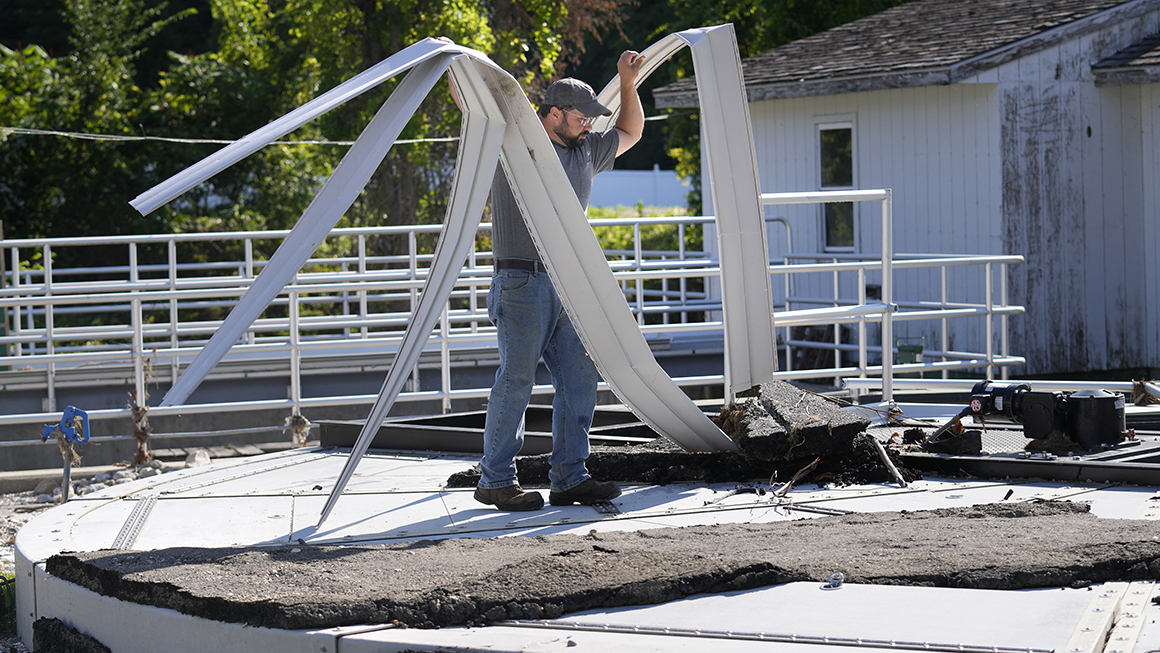
In 2021, the American Society of Civil Engineers graded the United States’ drinking water infrastructure a C– and its wastewater infrastructure a D+. Why? Across the country, sustainable water and wastewater systems are underfunded and old; many of them at the ends of their lifespans. From 1977 to 2014, federal funding for community water infrastructure decreased (PDF) from $76.27 per person to $13.68.
In rural areas especially, addressing infrastructure deterioration can be difficult, as the systems may lack maps, leaks are untraceable, and system operators are hard to attract, retain, and train. Rural systems do not have the customer base to support upgrades with rate payers alone, and external funding for proactive upgrades can be difficult to access, as federal or state funding tends to be dedicated to regulatory compliance issues. As a result, undermaintained and invisible water-related infrastructure often goes without upgrades until major problems arise.
Recently, Congress authorized $55 billion for water infrastructure, but it isn’t enough to cover total system needs nationwide. To best support rural community well-being, economic development, and environmental protection, policymakers should continue to fund and build a foundation of sustainable water and wastewater systems.
Understanding the scope of water system maintenance
Water system sustainability has several intertwined dimensions. First, systems must maintain operational capacity, meaning the ability to continue operations when system operators retire, system requirements change, or there are disruptions. Second, systems need adequate financial capacity, including the resources to upkeep systems with revenues generated from services provided and other reliable funding. Lastly, water systems need to be cognizant of their environmental impact and sustain access to safe water resources over time while maintaining the health and natural functions of water sources, particularly in the context of climate change.
Failure to upkeep systems has costs. System deterioration can lead to drinking water, groundwater, or soil contamination that harms humans and ecosystems. If systems are out of compliance, communities face fines for violations, which disproportionately affect communities of color. Industries linked to systems can be culprits in water violations too, and polluting facilities are more likely to be sited in low-income communities of color.
Climate change has made water systems harder to maintain as well. Aging water and wastewater systems are vulnerable to increasingly frequent and extreme weather events, such as freezes and heavy rains. Our research in rural Texas revealed that power outages during Winter Storm Uri prevented water treatment systems from functioning, leading to weeks of boil water alerts and record numbers of burst pipes. Heavy rains in Arkansas caused stormwater to back up through a business’s drain, and in Mississippi, moisture from a sewer back up after heavy rains caused black mold to grow in an adjacent apartment. In North Carolina, the lagoons servicing industrial hog operations overflowed after three separate hurricanes, harming the surrounding Black, Latino, and Indigenous communities.
Slower changes are happening too. In coastal communities, sea level rise prevents septic systems from properly filtering wastewater, resulting in groundwater contamination. Research has shown that communities of color are more likely to live in areas with poor drainage systems. In parts of Texas, another year of drought could lead to record lows in water reserves.
Investment in sustainable water systems is needed
Funders, policymakers, and communities can address the intertwined operational, financial, and environmental sustainability issues facing rural water and wastewater systems through the following actions:
- Invest in proactive improvements to increase climate resilience. Rural communities need funding for system improvements before they violate regulations, and local leaders can prioritize water and wastewater upgrades before there is an emergency. Proactive upgrades can drive down the costs from leaks, burst pipes, and other repairs exacerbated by climate change and prevent costly fines and ecosystem degradation that harms public health. Funding for proactive emergency planning can also help minimize losses and environmental harms when there are disruptions.
- Consider regionalization to spread out costs.Regionalization can range from sharing equipment and staff to merging systems and governance across communities so the operation costs are shared across a broader base. Strong working relationships among local leaders, system operators, and businesses can help facilitate access to funding for system improvements and decrease the burden on limited personnel that time-intensive grant applications create. A regionally integrated “one water” approach encourages communication among stakeholders so pollutants from upstream do not threaten public and environmental health downstream.
- Prioritize water-use efficiency to reduce costs and increase conservation. At the system level, technology can track water use and detect leaks, and monitoring can be enhanced by involving volunteer citizen scientists. Nature-based solutions such as constructed wetlands could filter pollutants while facilitating water reuse and wildlife habitats. Rural businesses can contribute too by recycling water with closed-loop and water treatment systems or by installing low-flow fixtures.
Steps taken now to improve water and wastewater infrastructure and operations in rural communities will go a long way toward achieving long-term sustainability that facilitates equitable outcomes in the face of climate change.
Let’s build a future where everyone, everywhere has the opportunity and power to thrive
Urban is more determined than ever to partner with changemakers to unlock opportunities that give people across the country a fair shot at reaching their fullest potential. Invest in Urban to power this type of work.